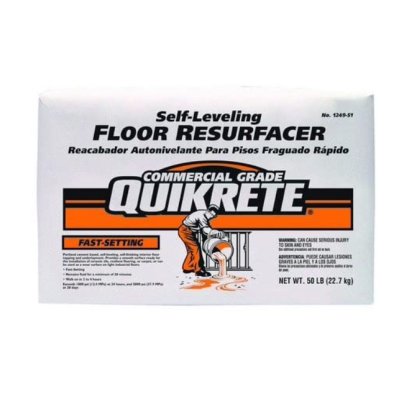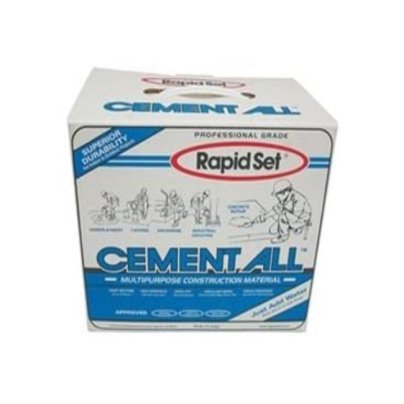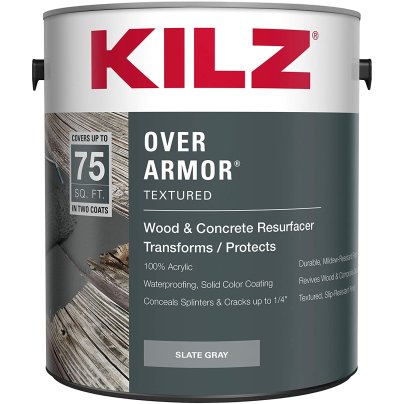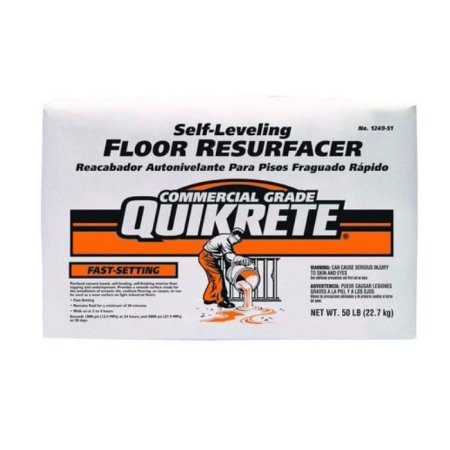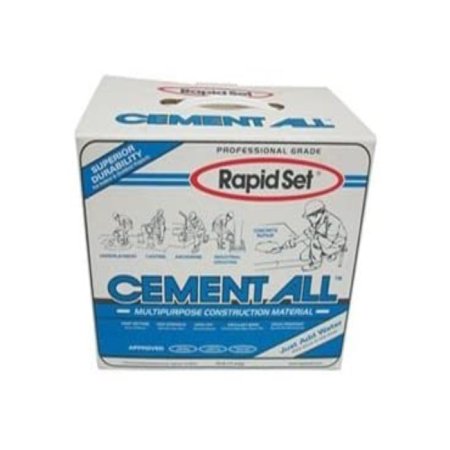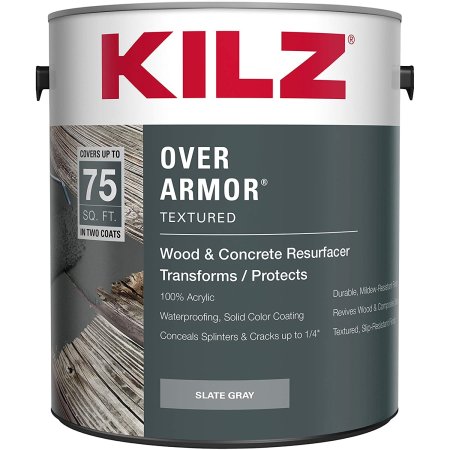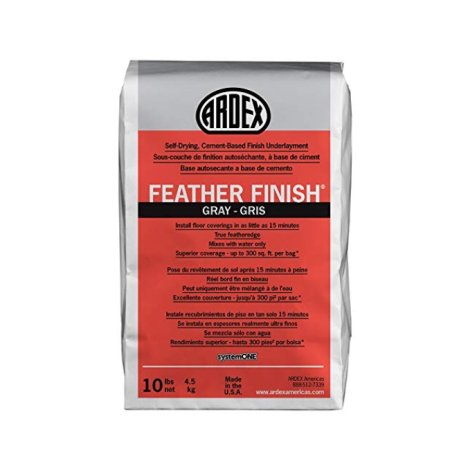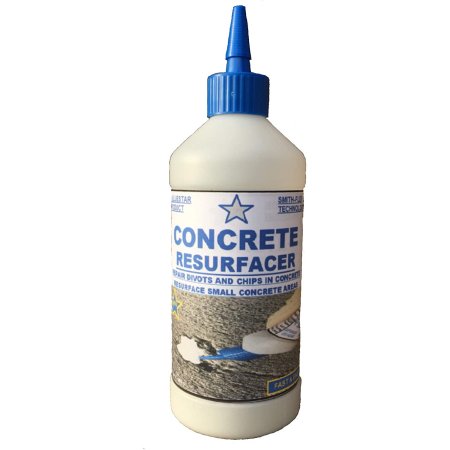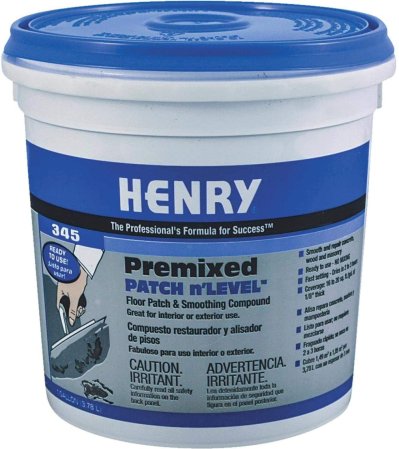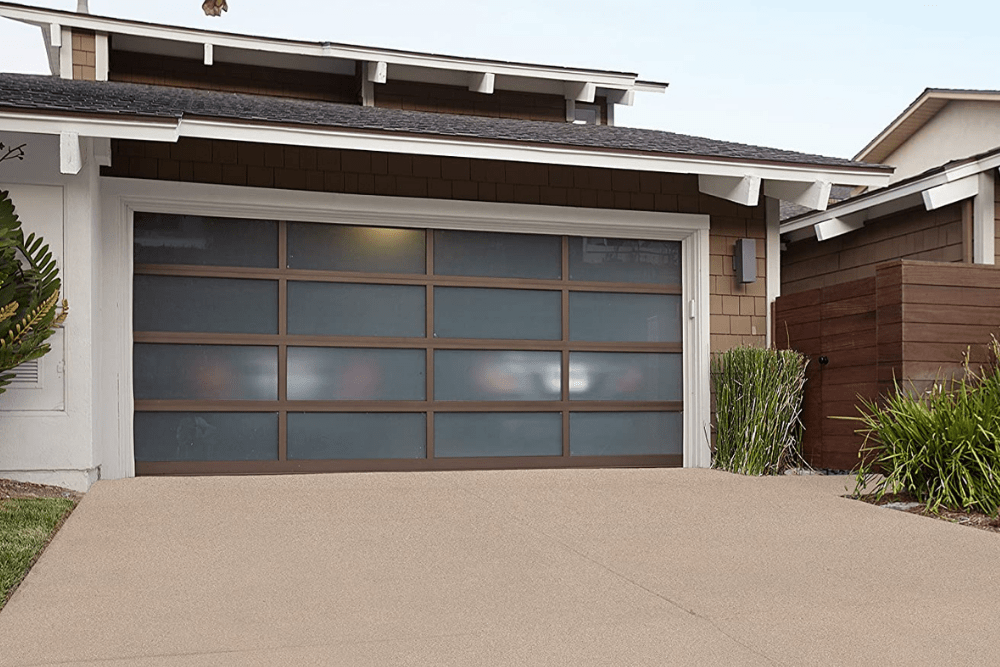
We may earn revenue from the products available on this page and participate in affiliate programs. Learn More ›
Although concrete surfaces are largely utilitarian features of a home, they can be an eyesore when they become cracked and chipped. However, replacing these surfaces just isn’t in the budget for most homeowners. Fortunately, concrete resurfacers can restore these exterior and interior features to pristine condition. Resurfacers adhere to the old concrete surface, creating an additional layer of material that smoothes over imperfections up to ½-inch deep and gives the surface a like-new appearance.
With so many resurfacing products on the market, it can be difficult to decide which one is right for your concrete project. This guide will dig deep to uncover the critical features of these products while reviewing some of the best concrete resurfacer on the market.
- BEST FOR INTERIORS: Quikrete Fast-Setting Self-Leveling Floor Resurfacer
- BEST FOR EXTERIORS: Rapid Set High Strength, 15 Min Set, Featheredge
- BEST FOR CRACKS: KILZ Over Armor Textured Wood/Concrete Coating
- BEST FOR FLOORING: Ardex Feather Finish Grey Self-Drying Cement
- BEST FOR SMALL JOBS: Bluestar Concrete Resurfacer
- BEST PREMIXED: Henry, W.W. Co. Pre-Mixed Floor Patch
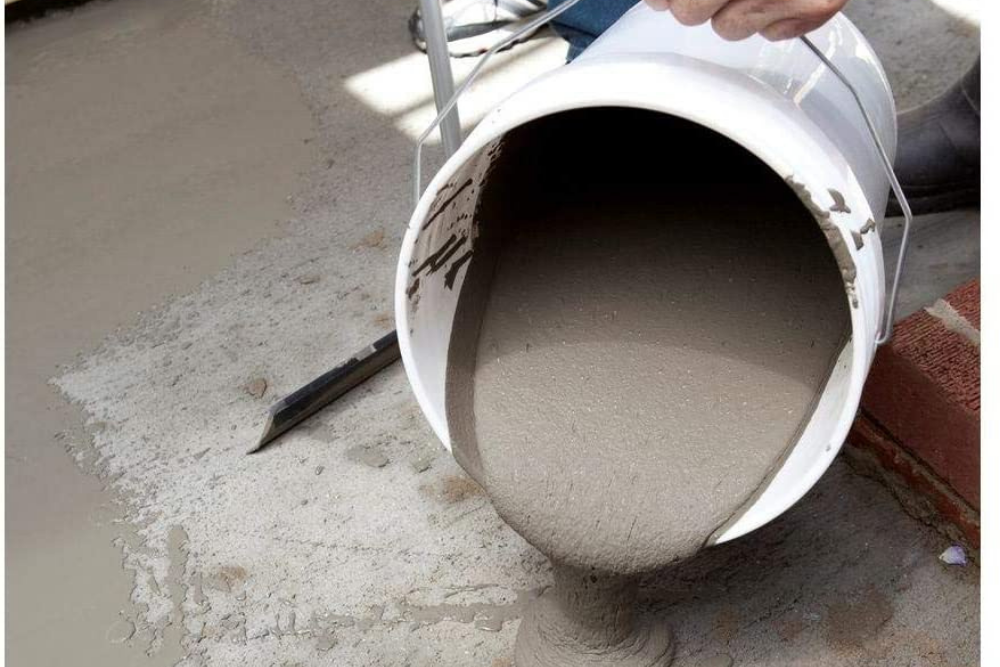
What to Consider When Choosing the Best Concrete Resurfacer
Not all resurfacers are equal. They can vary significantly in drying time, bonding properties, and abrasion resistance, all of which make them suitable for some projects and impractical for others. Ahead, learn more about these and other critical characteristics of the best concrete resurfacer.
Bonding Properties
Since you’ll be applying a concrete resurfacer over an existing surface, the product must bond well with that surface to ensure it doesn’t lift off, requiring additional repairs. Most concrete resurfacers adhere very well to concrete. Some products are more versatile than others and will also bond with other surfaces, including brick, stucco, metal, masonry, and even wood. Bonding properties are also important when repairing a subfloor to ensure the new flooring installed above the resurfacer will adhere.
Temperature Tolerance
Given that most concrete surfaces are outdoors, understanding the temperatures that concrete can tolerate during installation is critical. Most concrete resurfacers require the temperature to be above 50 degrees Fahrenheit during the installation process and for 24 hours afterward to ensure it dries properly.
Temperature also plays a role in the amount of working time the user has before the concrete sets and becomes too dry to move. In general, the higher the temperature, the faster the concrete will dry. If it’s over 90 degrees Fahrenheit, use cold water to slow the drying process. If it’s below 60 degrees, most manufacturers suggest using warm water to speed the dry time. Make sure to check the temperature guidelines on the package before applying the resurfacer.
Abrasion Resistance
Abrasion resistance is the concrete resurfacer’s ability to resist wear from the rubbing and friction of feet and tires. This is primarily determined by how hard the concrete resurfacer is once it fully cures. The best way to determine abrasion resistance is to look at the amount of pressure the resurfacer can withstand.
Concrete that serves as a driveway and needs to endure the weight and friction of cars should have a greater abrasion resistance than a walkway that only sees foot traffic. Concrete driveways should be able to withstand at least 4,000 pound per square inch (psi) once fully cured to endure the weight of a car. A 2,500 psi is adequate for walkways.
Decorative Finish
While function may sometimes be the reason for resurfacing concrete, it’s often a project intended to improve the look of aging and damaged concrete. With that in mind, remember to consider aesthetics when selecting a concrete product. Concrete resurfacing is available in different hues, ranging from slate gray to a tan, sandstone look. Of course, you can also paint most concrete to achieve a broader range of colors.
For projects that preserve part of the existing concrete, it’s essential to match the concrete colors as closely as possible. For a more decorative look, consider stone stamps to create textures that resemble natural stone or pavers.
Primer
In some cases, a primer is required to help adhere the old concrete to the new. Most concrete resurfacers include bonding agents that eliminate the need for a primer. For those that don’t, priming the surface is crucial to prevent the two surfaces from pulling apart, requiring more repairs. Primer typically consists of one part water and seven parts cement, applied as a middle layer between the old and new concrete. Apply the primer layer, and then immediately add the resurfacer to ensure good adhesion between the primer and the new concrete.
Drying Time
When choosing a concrete resurfacer, make sure the drying time suits the project. Concrete with fast drying times that allow the paved area to get back into service sooner may be convenient, but they require the user to work faster before the concrete is too hard to spread.
Concrete manufacturers usually list drying time in the number of minutes or hours it takes the concrete to set and dry for traffic. Once the concrete has set, it is not ready for use but is too hard to change.
Most concrete resurfacer sets within 1 to 2 hours after mixing. However, it can take a resurfacer between 6 and 24 hours to receive foot traffic and several days to receive vehicle traffic.
Amount Needed
Concrete resurfacer replaces concrete that has worn away from the surface. The more the concrete is worn away, the more product you’ll need to fill the missing parts. While a thinner product may be adequate for moderately worn concrete, a resurfacer with a thicker consistency is required for replacing more material. Thicker products can better fill cracks and crevices up to ½-inch deep. Thinner products, however, have self-leveling characteristics that make them easier to apply.
Different manufacturers use different ingredients that affect the consistency of their specific resurfacers. Depending on the amount of surface you need to replace, consider whether a thick or thin product is required. The consistency of some resurfacers can also be altered depending on how much water you add to them. This versatility allows for mixing a thicker batch for patching large chips and a thinner batch for resurfacing broad areas.
Application
Concrete resurfacer is available in two types: premixed and dry, which must be mixed with water prior to use. While premixed resurfacers offer convenience, they are typically more expensive than dry resurfacers. Dry resurfacers also allow you to tailor the consistency of the cement to suit your needs.
Most concrete resurfacer is applied by mixing the product with water (if needed) and then pouring it on the existing concrete and spreading with a squeegee. Before applying the resurfacer, thoroughly clean the surface to promote good adhesion between the old and new concrete. Repair any large chips greater than ⅛-inch deep or wide by mixing a batch of resurfacer with a thicker consistency.
Concrete is porous, so it acts as a rigid sponge that soaks up moisture. With this in mind, you’ll need to saturate the old concrete with water just prior to applying the resurfacer to prevent it from sucking moisture out of the resurfacer and drying improperly.
Concrete resurfacer only has about 30 minutes of working time, so don’t mix too much concrete at one time. Pour the resurfacer in 1-foot wide strips and use the squeegee to spread it evenly on the concrete slab. Use a concrete broom to create a nonslip texture on the surface of the concrete. If desired, add a concrete sealer to further extend the life of the concrete.
Our Top Picks
The list below narrows the field to some of the best products for a variety of different concrete resurfacing needs, ranging from repairing chips and cracks to leveling a subfloor for new flooring installation to giving an entire driveway a facelift.
Best For Interiors
Quikrete Fast-Setting Self-Leveling Floor Resurfacer
One of the tricky parts of resurfacing a concrete floor is properly leveling the new concrete. Quikrete’s resurfacer is ideal for covering up concrete marred by cracks and chips with its thinner consistency and ability to self-level. Simply mix the concrete with water, pour evenly over the old concrete, spread with a squeegee if needed, and marvel as it self-levels to a smoother surface.
The fast-setting formula hardens enough for foot traffic in just 6 hours. This is an excellent option for prepping a surface to lay tile or other types of flooring. Quikrete comes dry in a 50-pound bag, which provides enough coverage for 35 square feet at a ⅛-inch thickness.
Best for Exteriors
Rapid Set High Strength, 15 Min Set, Featheredge
Determining the proper cement for the type of project can be confusing, not to mention costly. Having a single product that can fulfill a variety of needs, such as this multipurpose cement from Rapid Set is ideal. Renewing a walkway or patio, grouting, anchoring, and a variety of other concrete applications are all in play with this material.
Mix this product to a thick or thin consistency to meet different applications, and watch it adhere to materials ranging from brick and stone to wood subfloor. It also sets more quickly than most cement, hardening to structural strength in just 1 hour. Rapid Set comes in a 55-pound bag, enough to cover half a cubic foot of space.
Best For Cracks
KILZ Over Armor Textured Wood/Concrete Coating
Think of this resurfacer from Kilz as a cross between paint and concrete repair. Though not thick enough to handle concrete with more extensive damage, the thinner consistency makes it easy to apply and ideal for resurfacing concrete that’s weathered and aged with more minor imperfections. The resurfacer will cover cracks and chips up to a ¼-inch deep and goes on like paint with a brush, roller, or sprayer, making it one of the easier concrete resurfacers to apply.
A slate gray color restores stained concrete to an even finish while its slip-resistant textured surface makes this resurfacer safe for walks, patios, and basement floors as well as wood. It sets quickly, drying in 4 to 6 hours for a second coat and fully curing after 3 days. However, this product is not hard enough for use on driveways and other driveable surfaces.
Best For Flooring
Ardex Feather Finish Grey Self-Drying Cement
A wide variety of applications make this Ardex self-drying cement a useful option for prepping a concrete surface for a new floor. It’s capable of functioning as a durable self-leveling underlayment for flooring ranging from ceramic tile to hardwood.
The superior bonding qualities of this cement make it suitable for installing over various types of materials, including wood, masonry, terrazzo, ceramic, and tile, without first priming the surface. It’s also strong enough to resurface a driveway or repair cracks and chips in a concrete patio. To use, mix with water, pour onto the surface, and spread with a trowel. Ardex comes in a 10-pound bag, which covers up to 300 square feet and dries in just 3 hours.
Best For Small Jobs
Bluestar Concrete Resurfacer
Resurfacing small jobs doesn’t have to involve hauling around 50-pound bags and the messy process of mixing concrete. This lightweight 16-ounce bottle will do the trick. Bluestar Concrete Resurfacer is premixed concrete. Simply shake the bottle, cut the applicator tip, squeeze to fill cracks and chips, and then level with a putty knife.
This product can fill areas up to ½-inch deep. Once the repair is complete, the tip is resealable, preserving the leftover cement for a later repair. This simple-to-use resurfacer is ideal for small repair projects to patios, driveways, and walkways when large batches of cement aren’t required.
Best Premixed
Henry, W.W. Co. Pre-Mixed Floor Patch
Premixed resurfacers don’t require the messy mixing process of dry cement mixes. While they aren’t practical for larger applications that require a lot of cement, they are a good choice for small jobs. This premixed floor patch from Henry is ideal for resurfacing small portions of a chipped and cracked concrete floor or repairing an aged subfloor for new flooring installation. The consistency makes it easy to apply the concrete smoothly while achieving a level finish with existing concrete.
The floor patch comes in a 1-gallon tub, which covers 20 square feet and dries in 2 hours. The tub is resealable, preserving the leftovers for other projects.
FAQs About Concrete Resurfacer
If you’re still wondering about how to install old concrete over new concrete or which resurfacer is appropriate for your project, then read on for answers to these and other frequently asked questions.
Q. Can I pour new concrete over old concrete?
You can apply new concrete over old concrete by first thoroughly cleaning the old concrete and saturating it with water. Make sure to use a concrete resurfacer, which includes bonding agents that allow the new surface to adhere to the old.
Q. Are driveway resurfacing products the same as concrete resurfacers?
That depends. Many concrete resurfacers can be used to resurface concrete driveways. However, asphalt driveways require an asphalt driveway resurfacer.
Q. How thick should concrete resurfacer be?
It depends on the repair. Concrete resurfacer can be as thin as 1/16 inch or as thick as ½ inch. Make sure to check the product’s specifications for its minimum and maximum thickness.
Q. Does concrete resurfacing last?
The superior bonding properties of concrete resurfacer mean it can last between 8 and 15 years.
Q. Will concrete resurfacer crack?
If installed properly, concrete resurfacer will not crack. That said, all concrete will eventually wear and crack over time.
